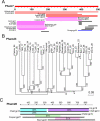Exploring the mycobacteriophage metaproteome: phage genomics as an educational platform
- PMID: 16789831
- PMCID: PMC1475703
- DOI: 10.1371/journal.pgen.0020092
Exploring the mycobacteriophage metaproteome: phage genomics as an educational platform
Abstract
Bacteriophages are the most abundant forms of life in the biosphere and carry genomes characterized by high genetic diversity and mosaic architectures. The complete sequences of 30 mycobacteriophage genomes show them collectively to encode 101 tRNAs, three tmRNAs, and 3,357 proteins belonging to 1,536 "phamilies" of related sequences, and a statistical analysis predicts that these represent approximately 50% of the total number of phamilies in the mycobacteriophage population. These phamilies contain 2.19 proteins on average; more than half (774) of them contain just a single protein sequence. Only six phamilies have representatives in more than half of the 30 genomes, and only three-encoding tape-measure proteins, lysins, and minor tail proteins-are present in all 30 phages, although these phamilies are themselves highly modular, such that no single amino acid sequence element is present in all 30 mycobacteriophage genomes. Of the 1,536 phamilies, only 230 (15%) have amino acid sequence similarity to previously reported proteins, reflecting the enormous genetic diversity of the entire phage population. The abundance and diversity of phages, the simplicity of phage isolation, and the relatively small size of phage genomes support bacteriophage isolation and comparative genomic analysis as a highly suitable platform for discovery-based education.
Conflict of interest statement
Competing interests. The authors have declared that no competing interests exist.
Figures







References
-
- Suttle CA. Viruses in the sea. Nature. 2005;437:356–361. - PubMed
-
- Hambly E, Suttle CA. The viriosphere, diversity, and genetic exchange within phage communities. Curr Opin Microbiol. 2005;8:444–450. - PubMed
-
- Fuhrman JA. Marine viruses and their biogeochemical and ecological effects. Nature. 1999;399:541–548. - PubMed
-
- Wilhelm SW, Suttle CA. Viruses and nutrient cycles in the sea. Bioscience. 1999;49:781–788.
Publication types
MeSH terms
Substances
Grants and funding
LinkOut - more resources
Full Text Sources
Other Literature Sources
Molecular Biology Databases

